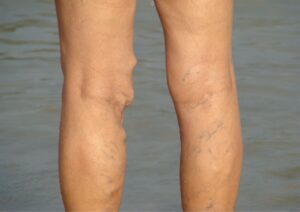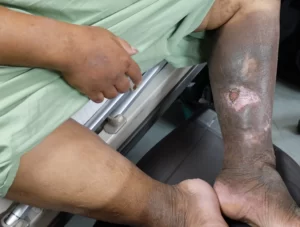Varicose veins and swollen legs or ankles can cause significant discomfort and affect the quality of life. While medical treatments are essential, complementary therapies like leg and foot massages can provide substantial relief. Here’s how these massages can benefit those suffering from varicose veins and swollen legs. It is important to understand how much pressure to apply during a leg massage, as light pressure can be more relaxing, while strong pressure reduces tension and pain in the muscles.
What are Varicose Veins and Swollen legs & ankles
Varicose veins occur when veins become enlarged, dilated, and overfilled with blood. They often appear swollen, raised, and have a bluish-purple or red color. This condition results from weakened or damaged valves in the veins, leading to poor blood flow and pooling.
Swelling in the legs and ankles, also known as edema, can result from various conditions, including chronic venous insufficiency, where the veins have trouble sending blood from the limbs back to the heart. Leg pain is a common symptom of these conditions and can be alleviated by massage.
Benefits of Leg and Foot Massage Therapy on the Blood Circulation and Leg Muscles
Improves Circulation: Massage stimulates blood flow in the legs, helping to reduce the pooling of blood in varicose veins. Enhanced circulation can also alleviate swelling by promoting the return of blood to the heart. Additionally, massage helps to promote blood circulation by stroking upward from the foot to the thighs, which increases blood flow and eases pain or tension in the legs.
Reduces Pain and Discomfort: Gentle massage techniques can help relieve the pain and discomfort associated with varicose veins and swollen legs. By reducing muscle tension and encouraging relaxation, massages can make daily activities more comfortable.
Decreases Swelling: Massage can aid in the movement of lymphatic fluid, which helps reduce swelling. This is particularly beneficial for those with edema, as it helps remove excess fluid from the tissues.
Enhances Venous Function: Regular massages can help improve the overall function of the veins in the legs. By promoting better blood flow and reducing vein pressure, massages can help prevent the worsening of varicose veins and reduce the likelihood of developing new ones.
Promotes Relaxation: Beyond physical benefits, massage therapy can also provide mental and emotional relief. The relaxation achieved through massage can reduce stress, which is often a contributing factor to various health issues, including poor circulation.
Increases Joint Range of Motion: Massage can increase joint range of motion by working on the leg muscles around a joint, enhancing flexibility and mobility.
Recommended Massage Techniques
Effleurage: This technique involves long, gliding strokes along the length of the leg. Effleurage helps improve blood circulation and warms up the muscle tissues, preparing them for deeper massage techniques. It is particularly effective for the lower leg and upper leg. When performing Effleurage, it is important to stroke upwards from the foot to the thigh to promote blood circulation.
Petrissage: This involves kneading and squeezing the muscles. Petrissage helps in stimulating blood flow and lymphatic drainage, reducing swelling and promoting relaxation.
Friction: Small, circular movements with the fingers or thumbs can help break down adhesions and improve blood flow. This technique should be used gently to avoid causing pain or discomfort.
Compression: Applying gentle pressure to the muscles and veins can enhance circulation and reduce muscle tension. This technique can be particularly soothing for swollen legs and ankles.
How to Massage The Legs?
Preparation
1. Create a Relaxing Environment: Ensure the room is warm and quiet. Use soft lighting and calming music if desired.
2. Use a Comfortable Surface: The person receiving the massage should lie down on a comfortable surface, such as a massage table or a bed.
3. Choose a Massage Oil or Lotion: Use a massage oil or lotion to reduce friction and make the massage more comfortable. Warm the oil in your hands before application.
Steps to Massage the Leg
1. Start with Effleurage:
– Technique: Use long, gliding strokes to warm up the muscles and spread the oil.
– Procedure: Place both hands at the ankle and gently glide up towards the thigh. Use gentle pressure and repeat several times.
2. Apply Petrissage:
– Technique: Use kneading motions to work deeper into the muscles.
– Procedure: Squeeze and release the muscles between your hands, moving from the ankle to the thigh. This helps improve circulation and muscle relaxation.
3. Perform Friction:
– Technique: Use small, circular motions to target specific areas.
– Procedure: With your fingertips or thumbs, apply gentle pressure in circular motions around the knee and calf muscles. This can help break down adhesions and improve blood flow.
4. Use Compression:
– Technique: Apply pressure to the muscles to stimulate blood flow.
– Procedure: Place your hands around the calf or thigh and gently press and release. This can be particularly soothing for swollen legs.
5. Incorporate Tapotement:
– Technique: Use light tapping or percussive movements.
– Procedure: Gently tap the muscles with the edge of your hands, fingers, or cupped hands. This technique helps stimulate the muscles and nerves.
6. Finish with Effleurage:
– Technique: Repeat the long, gliding strokes used at the beginning.
– Procedure: Glide your hands from the ankle to the thigh to relax the muscles and improve circulation once more.
Tips for Effective Leg Massage
Pressure: Adjust the pressure based on the recipient’s comfort level. Always start with gentle pressure and increase gradually if needed.
Direction: Always massage towards the heart to promote venous blood return.
Avoid Varicose Veins: If the person has varicose veins, avoid direct pressure on these areas. Focus on the surrounding muscles instead.
Hydration: Encourage the person to drink water after the massage to help flush out toxins released during the massage.
Precaution: Individuals at risk for blood clots should avoid massaging the inner thighs and should consult a healthcare provider before receiving a massage.
What is the best foot and leg massager for circulation
When looking for the best foot and leg massager to improve circulation, there are several highly recommended options that cater to different needs and preferences. Many massaging devices are designed to provide relief to the lower legs and feet. Here are some examples, although it is not an exhaustive list:
1. Human Touch Reflex Foot & Calf Shiatsu Massager
This massager is praised for its ergonomic design and figure-8 technology, which provides a soothing massage for both feet and calves. It helps stimulate blood flow and relieve muscle tension, making it ideal for those with poor circulation and swollen legs. The calf openings are comfortable, and the stimulating rollers under the feet offer a deep, relaxing massage【49†source】.
2. Cloud Massage Shiatsu Foot Massager
The Cloud Massager is highly recommended for its deep dual massage capabilities, adjustable settings, and wide openings for both feet and calves. It offers excellent quality massages and is particularly effective for tired and swollen ankles, feet, and calves. The design allows for comfortable positioning and versatile use【49†source】.
3. Fit King Leg Air Massager
The Fit King FT-057A is noted for its firm compression and built-in heat function. This updated model has three modes—sequence, circulation, and whole—that can be adjusted to different intensity levels. It’s user-friendly and effective for relieving chronic foot pain and improving circulation. The gentle heat element provides additional comfort for chilly feet and toes【50†source】.
4. Miko Shiatsu Foot Massager
The Miko Shiatsu Foot Massager offers deep-kneading massage with multiple pressure settings. It has a cool, futuristic design and is effective for a comprehensive foot massage. The device provides a strong, deep massage that can help improve circulation and relieve muscle tension in the feet【48†source】【49†source】.
5. Renpho Vibration Foot Massager
Renpho’s model combines powerful vibration with massage rollers, offering 20-speed settings for a customized massage experience. It’s effective for vibration therapy, providing relief from muscle pain and improving circulation. The remote control feature adds convenience, allowing adjustments without bending down【47†source】.
Each of these massagers has unique features that cater to different preferences and needs. For optimal results, consider your specific requirements, such as the need for heat, intensity levels, or specific areas of focus like calves or feet, when choosing the best massager for you.
Conclusion
Leg and foot massages can offer significant relief for those suffering from varicose veins and swollen legs or ankles. By improving circulation, reducing pain, and decreasing swelling, massage therapy can enhance the quality of life for individuals with these conditions. However, it’s essential to approach massage with caution and consult a healthcare provider to ensure it’s appropriate for your situation. Incorporating regular, gentle massage into your routine, alongside medical treatments, can provide a holistic approach to managing varicose veins and swelling.
For more detailed information and professional guidance, consider consulting with a licensed massage therapist or a healthcare provider specializing in venous conditions.










